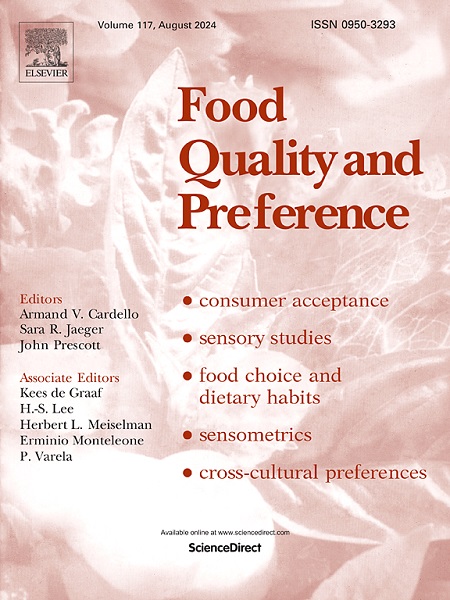Soft, crispy, crunchy, sustainable: The role of visual textures in shaping sustainable food preferences
IF 4.9
1区 农林科学
Q1 FOOD SCIENCE & TECHNOLOGY
引用次数: 0
Abstract
This research evaluates the potential of using visual textural complexity as a subtle yet effective strategy to direct consumer preferences towards more sustainable food choices, addressing the urgent need to reduce greenhouse gas emissions in the food industry.
Using a traditional Turkish rice pudding, sütlaç, as a case study, we prepared four variants with varying textural complexities (ranging from simple to complex) by reducing the portion size by half and gradually adding soft, crispy, crunchy, and airy textured food layers onto it. Two parallel sets of variants were formulated to minimize potential bias from differences in composition and visual properties of the layers. One hundred participants individually evaluated paired visual stimuli of these variants under two experimental conditions: non-informative, which included only visuals, and informative, which included visuals with accompanied by sample information.
Paired binary analysis revealed consistent preference for variants with higher levels of visual textural complexity, especially those with three layers (soft, crispy and crunchy), regardless of experimental conditions and product formulations. Although sample information affected preference scores, variants with certain levels of textural complexity were still preferred over the traditional sample (p < 0.05). Preferences for sample variants over the control reduced the carbon emission over 31 %. The study links the impact of visual textural complexity on preferences to the Elaboration Likelihood Model (ELM) and demonstrates that this strategy can effectively direct consumer preferences towards more sustainable options. Adopting the insights from this study can assist food producers and marketers in contributing to the broader goal of reducing carbon emissions.
软、脆、酥、可持续:视觉质感在塑造可持续食品偏好中的作用
本研究评估了将视觉纹理复杂性作为一种微妙而有效的策略来引导消费者偏好更可持续食品选择的潜力,以满足减少食品行业温室气体排放的迫切需要。我们以土耳其传统米布丁(sütlaç)为案例,通过将分量减半并逐渐添加柔软、酥脆、松脆和空气质地的食物层,制作了四种不同纹理复杂性(从简单到复杂)的变体。为了最大限度地减少因各层食物的成分和视觉特性不同而可能造成的偏差,我们设计了两组平行的变体。100 名参与者在两种实验条件下分别对这些变体的配对视觉刺激进行了评估:无信息(仅包括视觉效果)和有信息(包括视觉效果并附有样本信息)。配对二元分析表明,无论实验条件和产品配方如何,参与者都一致偏好视觉纹理复杂度较高的变体,尤其是有三层(软、脆和嘎嘣脆)的变体。尽管样本信息会影响偏好得分,但与传统样本相比,具有一定纹理复杂度的变体仍然更受偏好(p <0.05)。与对照组相比,对样本变体的偏好减少了 31% 以上的碳排放量。该研究将视觉纹理复杂性对偏好的影响与阐释可能性模型(ELM)联系起来,证明这一策略可以有效地引导消费者偏好更可持续的选择。采用本研究的见解可以帮助食品生产商和营销人员为实现减少碳排放这一更广泛的目标做出贡献。
本文章由计算机程序翻译,如有差异,请以英文原文为准。
求助全文
约1分钟内获得全文
求助全文
来源期刊

Food Quality and Preference
工程技术-食品科技
CiteScore
10.40
自引率
15.10%
发文量
263
审稿时长
38 days
期刊介绍:
Food Quality and Preference is a journal devoted to sensory, consumer and behavioural research in food and non-food products. It publishes original research, critical reviews, and short communications in sensory and consumer science, and sensometrics. In addition, the journal publishes special invited issues on important timely topics and from relevant conferences. These are aimed at bridging the gap between research and application, bringing together authors and readers in consumer and market research, sensory science, sensometrics and sensory evaluation, nutrition and food choice, as well as food research, product development and sensory quality assurance. Submissions to Food Quality and Preference are limited to papers that include some form of human measurement; papers that are limited to physical/chemical measures or the routine application of sensory, consumer or econometric analysis will not be considered unless they specifically make a novel scientific contribution in line with the journal''s coverage as outlined below.
 求助内容:
求助内容: 应助结果提醒方式:
应助结果提醒方式:


